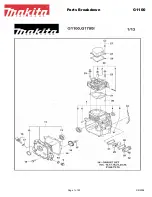
18
Setup Guide
Getting Started
Choosing the proper grind angle is important to achieving the weld
penetration, bead appearance, and arc cone width that you desire.
While there is no true
“
one size fits all
”
angle, there are some general
rules of thumb to observe:
•
Always grind in
-
line with the length of the tungsten. Never make
radial grind (in the direction of the circumference) marks on the
tungsten which will cause arc instability. Never grind with the
tungsten held parallel to the stone face.
•
For most applications, grind a point that is 2 –
2.5
times in length
than the tungsten is wide. This will create an angle of about 30
to 35 .
•
For AC, a more blunt angle may be used (around a 60 degree)
for best penetration. However, the 2 to 3 times in length rule will
still work for many circumstances.
•
For higher amperages, you will want to put a slightly truncated tip
on the tungsten.
•
Grip the tungsten firmly and slowly rotate it while grinding.
What Type of Grind Works Best?
•
Never use a radial grind pattern. This can be caused by grinding
at the wrong angle, or spinning the tungsten too fast while
grinding at the proper angle. The arc will be unstable.
•
Grind the angle so that the length of the grind measures 2 to 2.5
times the wide of the tungsten (For general purpose use this
should form about a 30 to 35 angle.) A slightly blunted end
(truncated) may be used if the amperage is over 50A to prevent
the tungsten from breaking off into the metal while welding.
•
AC welding may require a blunter point for some applications
where greater penetration is desired. It may seem counter
-
intuitive, but this will create a narrower arc cone and provide
more penetration.
<50 A
2.5
–
3
X Ø (DIAMETER)
>50 A
As you use the tungsten (depending upon the type you have select-
ed) you will notice that the tungsten will gently form more of a point-
ed dome as it is used, especially on AC. This is normal and the arc
will remain stable. Depending upon what arc properties you are look-
ing for, you may periodically want to regrind your tungsten to main-
tain optimal arc characteristics.
AC
IMPORTANT! Don
’
t Ball The Tungsten.
If you
’
ve ever operated an older transformer welder, or an early invert-
er, you were probably balling the tungsten when welding on AC. In
fact tons of literature exist about proper size ball, how to ball etc. In
fact, well meaning instructors and seasoned welders (who have never
worked with an inverter) may even insist you weld this way today.
However this is no longer true with an inverter. In fact, if you insist
on balling tungsten with an inverter, you are going to create an unsta-
ble arc, and in general hate the way it will weld. Be warned. Don
’
t
blame the machine. Blame the ball.
Why? The old
“
Green
”
tungsten is considered to be pure tungsten.
This meant that it did not handle heat as well at higher temperatures
as with the more modern tungsten blended with rare earth metal ox-
ides, and would even ball on its own as it was used. But it was also
needed to hold a certain type of arc cone. An intentional ball would
help the tungsten handle the arc better on a transformer.
Modern inverters treat green tungsten rather roughly, and you
’
ll
quickly end up with a huge, molten liquid ball dangling at the end of
the tungsten on AC. This is in part due to the short off time between
polarity change from + to
-
and back to + during the AC cycle. In fact
this time is so short, that inverters do not need High Frequency Stabi-
lization (HF) while welding AC, and do not have it. In fact HF is only
used for establishing the arc, then the HF shuts off automatically. The
extra
“
time on
”
of the arc means the tungsten is hotter, and pure
tungsten (green) isn
’
t able to handle the heat and will over
-
ball. That
is why rare earth metal
-
oxide blends are recommended. They do
handle the heat better and actually conduct electricity better. So they
do not need a ball. If given enough heat at the high end of their
operating range (for the diameter of the tungsten) they will form a
slight, but neatly elongated dome. But this dome still isn
’
t a ball.
If you think about it, the big ball at the end is really a large
“
target
”
for
the arc to jump to as it reverses polarity. When the electrons begin to
flow from the plate to the tungsten, that is a bigger target for the elec-
trons to hit, so the arc could end up anywhere along that balled sur-
face. The bigger the target, the more room for the arc to oscillate
around the ball, creating a randomly wandering arc. This is why
pointed tungsten is recommended with inverters.
Содержание PowerPro 164Si
Страница 46: ...46...
















































